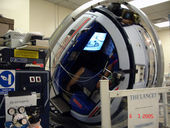
The brain is traditionally thought to sense body position in three ways. The inner ears sense motions of the head; the eyes see where the head is; and tiny sensory organs in muscles and tendons sense where the rest of the body is. More recently, researchers have realized that sensors in many other parts of the body also play a role: in the abdomen, the lower organs, and even blood vessels. As long as all of these sensors send matching signals to the brain, we feel oriented. But if one or two don't match up, the brain gets confused and we become nauseated.
Scientists knew the most sickening motions closely match the rate of natural breathing; they also knew that people naturally tend to breathe in time with a motion. In fact, Navy seamen in World War II discovered that they could use certain breathing tricks to combat motion sickness. But no one had ever tested whether breathing out of time with a motion could prevent nausea.
Researchers from Imperial College London enlisted 26 volunteers to sit in a tilting, rocking flight simulator and coordinate their breathing in various ways with the motion. The tests lasted up to 30 minutes, or until subjects felt moderately sick. The natural tendency was for volunteers to inhale on every backward tilt, in rhythm with the rocking. But if the subjects exhaled on every backward tilt, they didn't get sick as quickly. They felt even better if they breathed slightly faster or slower than the cyclic heaving of the chair; using that technique, the time until onset of nausea was 50% longer than during normal breathing.
So why do these tactics work? Abdominal sensors are known to send motion signals to the brain more slowly than those in the inner ear because they're farther away from the brain and because abdominal organs have more mass, which means they resist movement a tiny bit longer. The time lag between the two types of sensors creates a mismatch that builds up in the brain and makes us gradually sicker, the researchers say. But if the diaphragm opposes gravity-induced stomach motions with controlled breaths, there is less sensory conflict and less nausea. "This technique is very good for mild everyday challenges," says medical research scientist Michael Gresty, a member of the study team. "It's completely safe, and it's not a drug." The results appear in the December issue of Autonomic Neuroscience.
"It's a carefully designed study that shows there's some modest effect of controlled respiration on motion sickness," says neuroscientist Carey Balaban of the otolaryngology department at the University of Pittsburgh in Pennsylvania. But, he says, more controlled experiments are needed to confirm the proposed mechanism.



Reader Comments
to our Newsletter